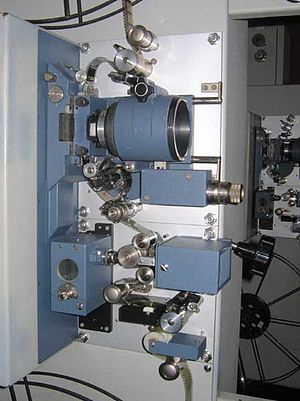
The Lumière brothers, Auguste Marie Louis Nicolas Lumière and Louis Jean Lumière, were French manufacturers of photography equipment, best known for their Cinématographe motion picture system and the short films they produced between 1895 and 1905, which places them among the earliest filmmakers.

The Motion Picture Patents Company, founded in December 1908 and effectively terminated in 1915 after it lost a federal antitrust suit, was a trust of all the major US film companies and local foreign-branches, the leading film distributor and the biggest supplier of raw film stock, Eastman Kodak. The MPPC ended the domination of foreign films on US screens, standardized the manner in which films were distributed and exhibited within the US, and improved the quality of US motion pictures by internal competition. It also discouraged its members' entry into feature film production, and the use of outside financing, both to its members' eventual detriment.
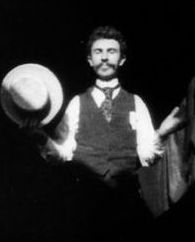
William Kennedy Laurie Dickson was a British inventor who devised an early motion picture camera under the employment of Thomas Edison.

35 mm film is a film gauge used in filmmaking, and the film standard. In motion pictures that record on film, 35 mm is the most commonly used gauge. The name of the gauge is not a direct measurement, and refers to the nominal width of the 35 mm format photographic film, which consists of strips 1.377 ± 0.001 inches (34.976 ± 0.025 mm) wide. The standard image exposure length on 35 mm for movies is four perforations per frame along both edges, which results in 16 frames per foot of film.
The following is an overview of the events of 1895 in film, including a list of films released and notable births.
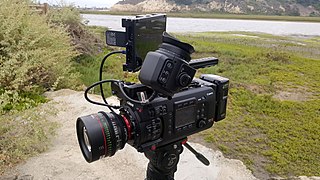
A movie camera is a type of photographic camera that rapidly takes a sequence of photographs, either onto film stock or an image sensor, in order to produce a moving image to display on a screen. In contrast to the still camera, which captures a single image at a time, the movie camera takes a series of images by way of an intermittent mechanism or by electronic means; each image is a frame of film or video. The frames are projected through a movie projector or a video projector at a specific frame rate to show the moving picture. When projected at a high enough frame rate, the persistence of vision allows the eyes and brain of the viewer to merge the separate frames into a continuous moving picture.

The Kinetoscope is an early motion picture exhibition device, designed for films to be viewed by one person at a time through a peephole viewer window. The Kinetoscope was not a movie projector, but it introduced the basic approach that would become the standard for all cinematic projection before the advent of video: it created the illusion of movement by conveying a strip of perforated film bearing sequential images over a light source with a high-speed shutter. First described in conceptual terms by U.S. inventor Thomas Edison in 1888, it was largely developed by his employee William Kennedy Laurie Dickson between 1889 and 1892. Dickson and his team at the Edison lab in New Jersey also devised the Kinetograph, an innovative motion picture camera with rapid intermittent, or stop-and-go, film movement, to photograph movies for in-house experiments and, eventually, commercial Kinetoscope presentations.
Thomas J. Armat was an American mechanic and inventor, a pioneer of cinema best known through the co-invention of the Edison Vitascope.

The Biograph Company, also known as the American Mutoscope and Biograph Company, was a motion picture company founded in 1895 and active until 1916. It was the first company in the United States devoted entirely to film production and exhibition, and for two decades was one of the most prolific, releasing over 3000 short films and 12 feature films. During the height of silent film as a medium, Biograph was the most prominent U.S. film studio and one of the most respected and influential studios worldwide, only rivaled by Germany's UFA, Sweden's Svensk Filmindustri and France's Pathé. The company was home to pioneering director D. W. Griffith and such actors as Mary Pickford, Lillian Gish, and Lionel Barrymore.
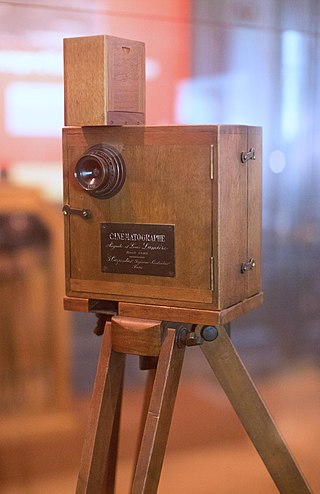
Cinematograph or kinematograph is an early term for several types of motion picture film mechanisms. The name was used for movie cameras as well as film projectors, or for complete systems that also provided means to print films.

Major Woodville Latham (1837–1911) was an ordnance officer of the Confederacy during the American Civil War and professor of chemistry at West Virginia University. He was significant in the development of early film technology.
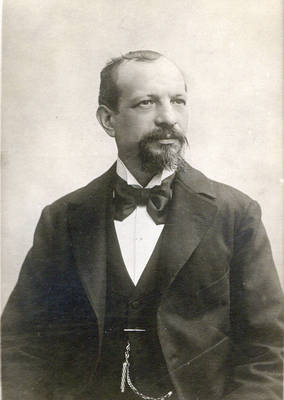
Eugène Augustin Lauste was a French inventor instrumental in the technological development of the history of cinema.

Vitascope was an early film projector first demonstrated in 1895 by Charles Francis Jenkins and Thomas Armat. They had made modifications to Jenkins' patented Phantoscope, which cast images via film and electric light onto a wall or screen. The Vitascope is a large electrically-powered projector that uses light to cast images. The images being cast are originally taken by a kinetoscope mechanism onto gelatin film. Using an intermittent mechanism, the film negatives produced up to fifty frames per second. The shutter opens and closes to reveal new images. This device can produce up to 3,000 negatives per minute. With the original Phantoscope and before he partnered with Armat, Jenkins displayed the earliest documented projection of a filmed motion picture in June 1894 in Richmond, Indiana.

Actuality film is a non-fiction film genre that uses footage of real events, places, and things, a predecessor to documentary film. Unlike documentaries, actuality films are not structured into a larger narrative or coherent whole. During the era of early cinema, actualities—usually lasting no more than a minute or two and usually assembled together into a program by an exhibitor—were just as popular and prominent as their fictional counterparts. The line between "fact" and "fiction" was not as prominent in early cinema as it would become once documentaries became the predominant non-fiction filmmaking form. Actuality as a film genre is related to still photography.
The Eidoloscope was an early motion picture system created by Eugene Augustin Lauste, Woodville Latham and his two sons through their business, the Lambda Company, in New York City in 1894 and 1895. The Eidoloscope was demonstrated for members of the press on April 21, 1895, and opened to the paying public on Broadway on May 20.

Herman Casler was an American inventor and co-founder of the partnership called the K.M.C.D. Syndicate, along with W.K-L. Dickson, Elias Koopman, and Henry N "Harry" Marvin, which eventually was incorporated into the American Mutoscope Company in December 1895.
The decade of the 1890s in film involved some significant events.
Enoch J. Rector was an American boxing film promoter and early cinema technician. He was a partner in Woodville Latham's Kinetoscope Exhibition Company during the mid-1890s, working with Latham and his sons Otway and Grey, as well as fellow cinema technicians William Kennedy Laurie Dickson and Eugene Lauste.

The history of film technology traces the development of techniques for the recording, construction and presentation of motion pictures. When the film medium came about in the 19th century, there already was a centuries old tradition of screening moving images through shadow play and the magic lantern that were very popular with audiences in many parts of the world. Especially the magic lantern influenced much of the projection technology, exhibition practices and cultural implementation of film. Between 1825 and 1840, the relevant technologies of stroboscopic animation, photography and stereoscopy were introduced. For much of the rest of the century, many engineers and inventors tried to combine all these new technologies and the much older technique of projection to create a complete illusion or a complete documentation of reality. Colour photography was usually included in these ambitions and the introduction of the phonograph in 1877 seemed to promise the addition of synchronized sound recordings. Between 1887 and 1894, the first successful short cinematographic presentations were established. The biggest popular breakthrough of the technology came in 1895 with the first projected movies that lasted longer than 10 seconds. During the first years after this breakthrough, most motion pictures lasted about 50 seconds, lacked synchronized sound and natural colour, and were mainly exhibited as novelty attractions. In the first decades of the 20th century, movies grew much longer and the medium quickly developed into one of the most important tools of communication and entertainment. The breakthrough of synchronized sound occurred at the end of the 1920s and that of full color motion picture film in the 1930s. By the start of the 21st century, physical film stock was being replaced with digital film technologies at both ends of the production chain by digital image sensors and projectors.
